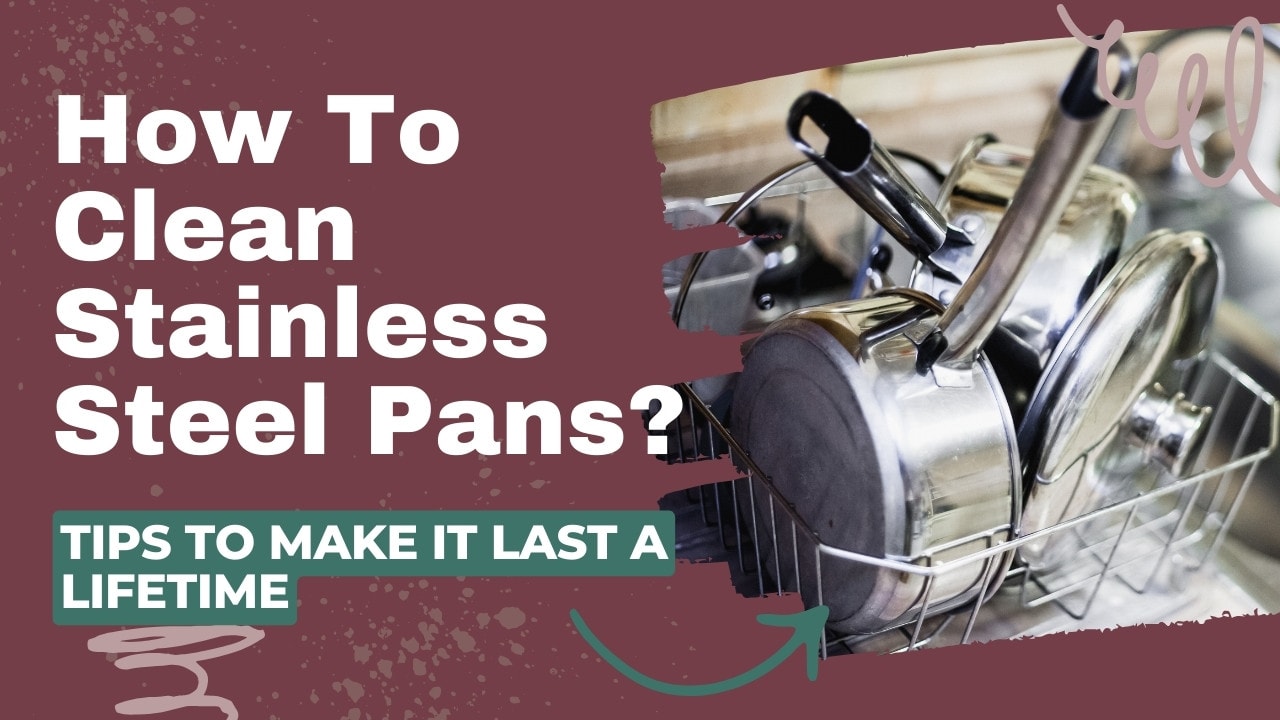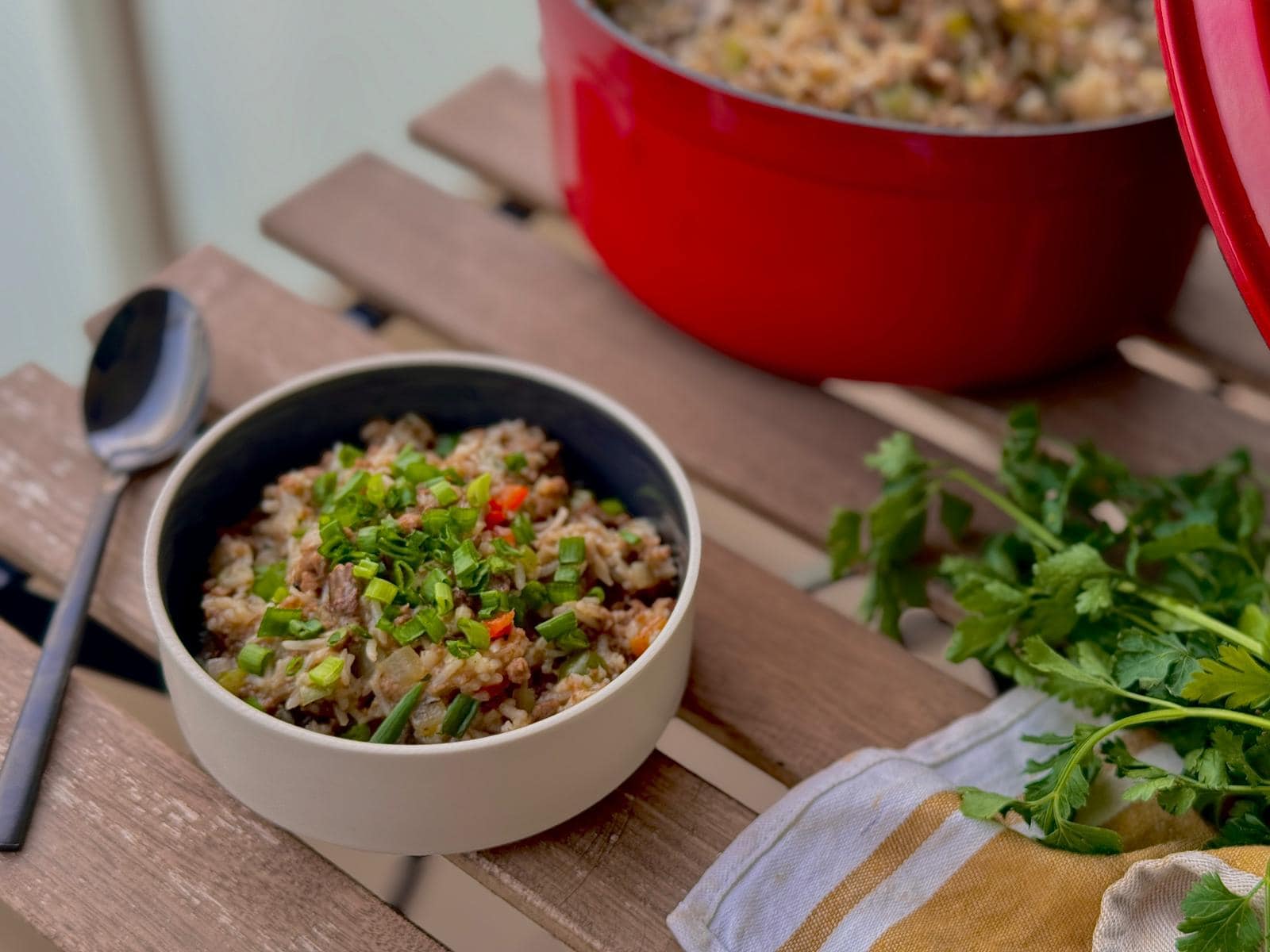I own wonderful US-made stainless steel cookware and have used it daily for four decades. So I have my day-to-day cleaning routine down pat. It doesn’t take much: I use a sponge or cloth, and warm, soapy water to clean my stainless steel pans. Then I grab a tea towel to ensure it’s thoroughly dry before storing my cookware properly.
Harder-to-clean pans with food residues or burnt-on stains take a little more TLC, but are quick and easy to restore once you know how to clean stainless steel pans. For these deeper cleans, all you need is some water, vinegar, or baking soda and a little time to bring your pans back to sparkling clean.
What is the Best Way to Clean Stainless Steel Pans?
The best way to clean stainless steel pans is to skip the dishwasher and wash them with warm, soapy water and a sponge or cloth. For harder stains, residues, or burnt-on food, use equal parts vinegar and water and simmer until the food lifts when gently scraped with a scraper.
There are other homemade options and commercial cleaners as well, which we will discuss in the sections below. But let’s cover the day-to-day cleaning of your stainless steel cookware step-by-step now.
What You Will Need
For this tutorial, you will need:
How to Clean Stainless Steel Pans Step-By-Step
Step 1: Deglaze the pan if necessary
Deglazing is a cooking term for removing or dissolving any browned or stuck-on food from the bottom of the pan by adding some water, stock, or broth to make a sauce or gravy. It’s also called the pan sauce method. It’s very popular with chefs in restaurants, since it not only adds amazing flavor to a dish but it’s also the first step toward a clean pan.
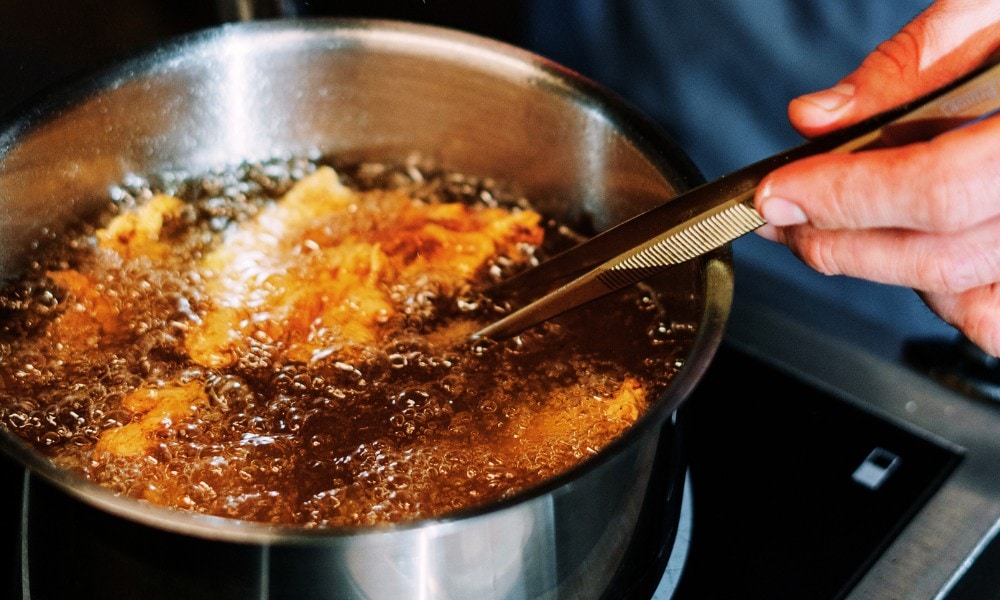
Step 2: Allow the pan to cool
Always allow stainless steel cookware to cool from cooking before you clean it. Never add cold water to a hot pan because it can cause warping. It can also be dangerous to you! If you add cold water to hot oil, it will splutter and throw hot oil out of the pan onto your skin, burning it.
Step 3: Gently hand wash/scrub
Using a sponge, dishcloth, or soft scour pad, you will be able to clean stainless steel cookware in most cases. In the case of harder-to-remove discolorations, burnt sauces, or burnt-on food, then you may be tempted to use something harder like steel wool. Don’t do it! Steel wool scratches the bottom of the pan, cutting down the longevity of your cookware. A netted nylon scour is a better option.
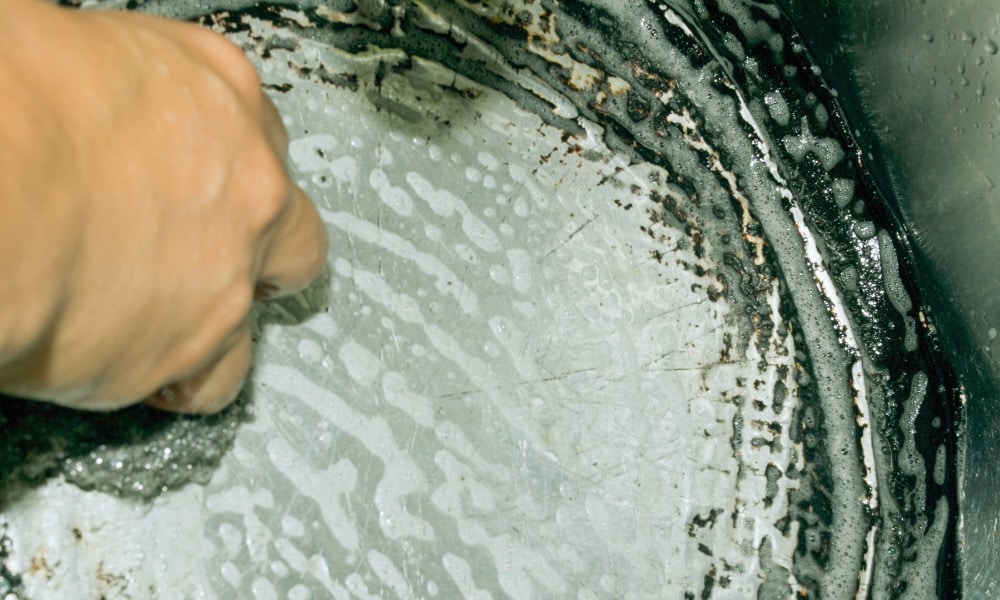
Just use warm, soapy water and wash normally. Then dry and store properly.
Stainless steel pots and pans will last a lifetime when cleaned properly and looked after. Mine are considered vintage (bought back in the 60s by my mum), and they’re still a joy to cook with, making perfect meals every time.
How to Deep Clean Stainless Steel Pans
Removing tough stains is easy using some ingredients found in your kitchen, like vinegar or baking soda. Here’s how to do a deeper clean to remove discolorations, burnt-on sauces, or food. It’s easy and quick, and there’s just something about that shiny silver pan at the end of it that makes you feel good.
Step 1: Cool the Pan to Avoid Thermal Shock
Allow the pan to cool down from cooking. It doesn’t have to be cold; it can be warm to cool but not hot.
Step 2: Add Vinegar and Water
Add equal parts vinegar and water. Half a cup of water, half a cup of white vinegar works for smaller pans, and a full cup of each works for larger pans. Bring this to a boil, then reduce the heat and let it simmer for five to ten minutes. You will see the burnt-on food start to lift.
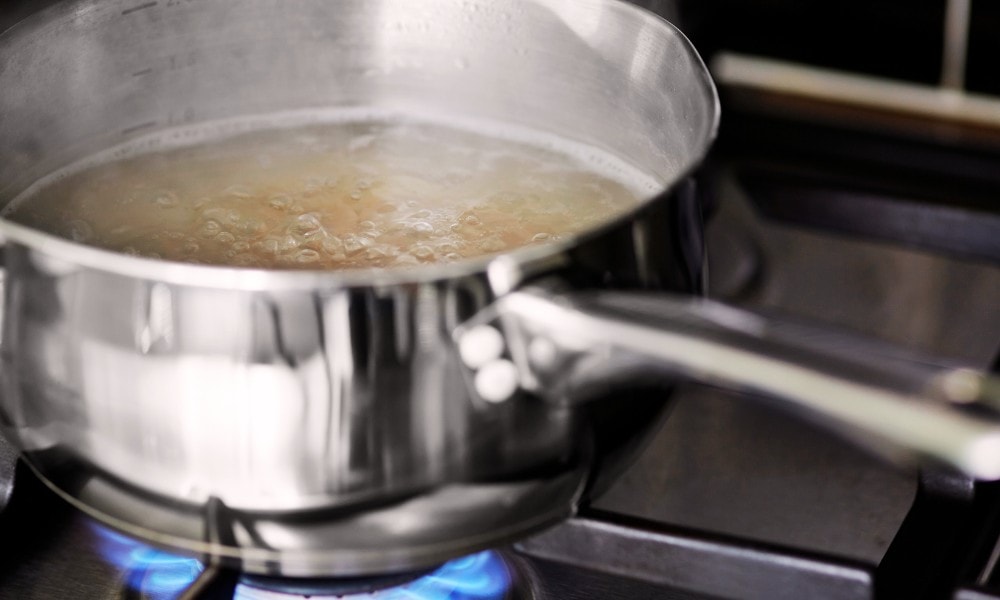
Step 3: Stir and Scrape
Using the correct utensils for stainless steel cookware – a wood, silicon, bamboo, or plastic scraper – gently scrape the bottom of the pan until the remaining burnt-on food lifts.
Step 4: Hand Wash
Wash as normal with warm, soapy water, dry thoroughly and store properly.
Can You Wash Stainless Steel Pans in the Dishwasher?
Yes, you can put good-quality stainless steel (18/10 grade) pans in the dishwasher. Lower grade (18/8 grade), usually used in budget stainless steel cookware, can be affected by the high temperatures of a dishwasher, so I recommend hand washing.
How do you know if they are dishwasher-safe?
Manufacturers will state if the stainless steel cookware you have purchased is dishwasher safe. When purchasing through Amazon, most brands will list it in the title and product descriptions, like this Viking Culinary Contemporary stainless steel cookware set, for example.
How To Prepare Pans To Put In The Dishwasher
Allow your stainless steel pans to cool. Then, rinse them thoroughly before putting them in the dishwasher. Remove all excess oils and food residues beforehand; otherwise, sometimes, they can be baked-on in the high temperatures of a dishwasher and be even harder to remove.
Can You Soak Stainless Steel Pans?
Yes, you can soak stainless steel pans as long as they have 10% nickel content or higher. Rust is not a concern because of the composition of stainless steel. An alloy made of chromium, nickel, and iron, high-quality stainless steel, like that found in cookware, is rust-proof.
If you choose nickel-free cookware for health reasons, however, you may want to avoid soaking it. If your cookware has exposed aluminum at the base, rims, or rivets, that could also rust if it’s soaked.
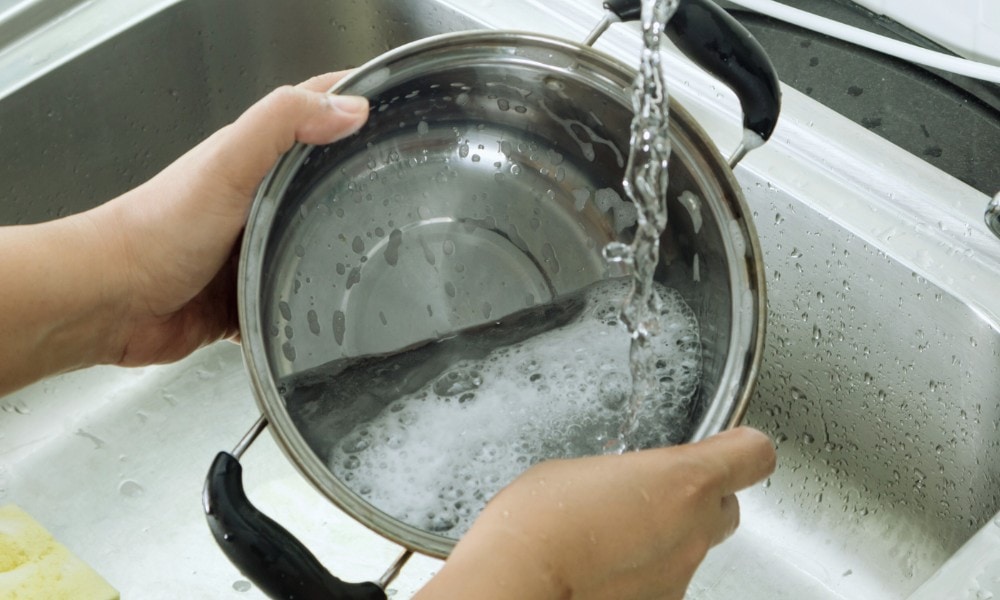
The choice to soak your pan in warm or cold water depends on what was cooked in the pan.
Proteins (eggs, meats) are best soaked in cold water with a little dish soap added. While sugar-based burnt food (desserts, sauces, caramel) is best soaked in hot water with a little dish soap. The heat helps dissolve the sugar particles so they lift.
How To Remove Burnt Oil on Stainless Steel Pans
Burnt oil and burnt-on foods are not too hard to remove with equal parts vinegar and water. Place water and vinegar in the pan, heat over medium heat, and let it simmer for 5-10 minutes. After boiling vinegar, the burnt oil residues can be cleaned away with the wipe of a dishcloth. For food residues, they will lift when scraped gently with a wood, plastic, or silicone scraper. Then wash with warm, soapy water.
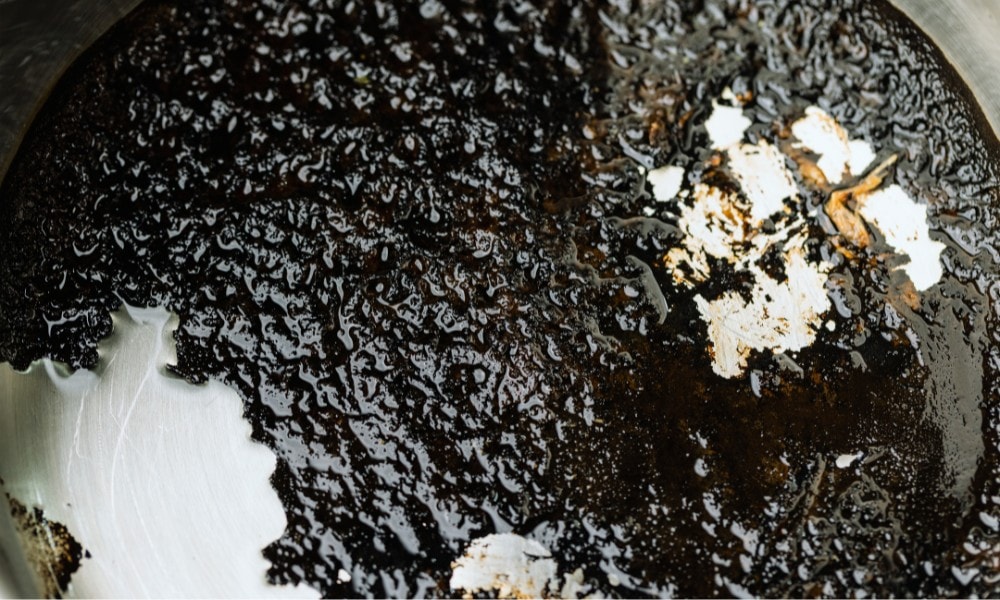
How to Remove Rainbow Discoloration on Stainless Steel Pans
Removing rainbow discoloration from stainless steel is as easy as sprinkling some baking soda on the bottom of the pan and using a cut lemon to scrub it. Both lemon and baking soda are powerful natural cleaners made into a paste. Baking soda’s natural soft abrasiveness removes discoloration while not damaging your stainless steel cookware. You can also use the equal parts vinegar and water method.
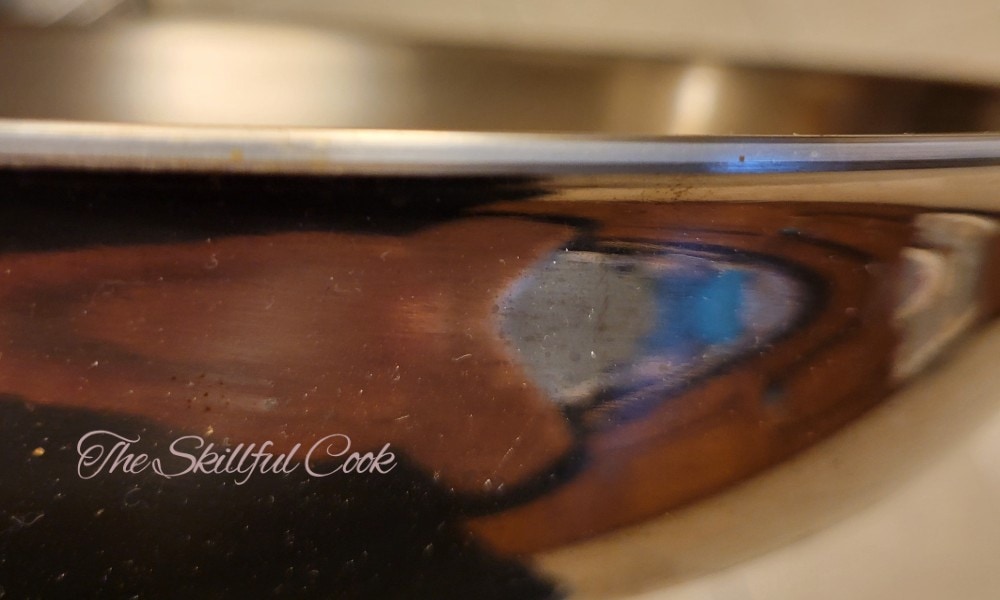
Heavy Duty Cleaners
In those instances where you feel like you need to bring in the big guns – the commercial cleaners – then Bar Keepers Friend is excellent for cleaning stainless steel cookware. It’s safe and easy to use; the oxalic acid cleans stainless steel, bringing it back to a sparkling, shiny, brand-new look.
How to Keep Stainless Steel Shiny
Sometimes, even after removing the gunk and cleaning properly, the sparkle is gone, and there is a matte look to your pan. Mineral or salt deposits from water and foods or pitting (from excess salt eating away at your pan) will affect the shininess of your stainless steel.
When this happens, just add a little water to your pan, sprinkle in some Bar Keepers Friend, and clean with a dishcloth or soft scrub pad. It will gently remove those last few remnants and bring back the shiny stainless steel underneath. I find I only need to do this occasionally (like once a year) because, usually, the vinegar/water method is enough to clean my stainless steel pans properly.
General Care & Maintenance To Keep Them Shiny New
I prefer to use natural products. They’re cheaper, easy to use, non-allergenic, and safe for everyone in the household, including pets. This is how I clean my stainless steel pots and pans.
- Always allow your pans to cool before cleaning.
- Wash with warm, soapy water.
- For tougher residues, clean using the vinegar/water method described above.
- Dry thoroughly to stop any chance of salt residue corrosion.
- When putting them away, store them correctly. I use pan protectors in between each pot or pan to stop scratching. Don’t throw them on top of each other. Over the years, I’ve broken handles this way.
Reminder: choosing to season stainless steel pan is an option, but seasoned stainless steel pans won’t stay shiny because a nonstick patina of polymerized and carbonized oil develops on nonstick pans. This doesn’t mean it’s not clean; it will just have a dark finish rather than a shiny one.
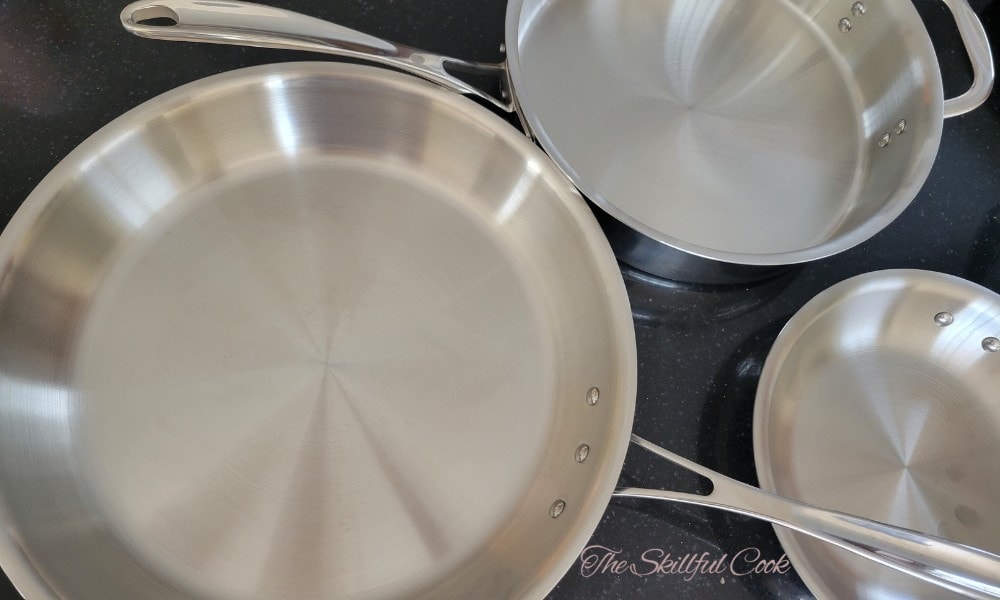
Conclusion
Cleaning stainless steel cookware and keeping it that way takes a little elbow grease, but it’s not hard! I use equal parts vinegar and water for just about everything. But when it comes to stuck-on food, I can’t resist making a nice sauce or gravy, which also helps me clean the pan, so it’s a win-win!
We’d love to hear from you about how you clean your stainless steel cookware, so drop us a line in the comments below.

